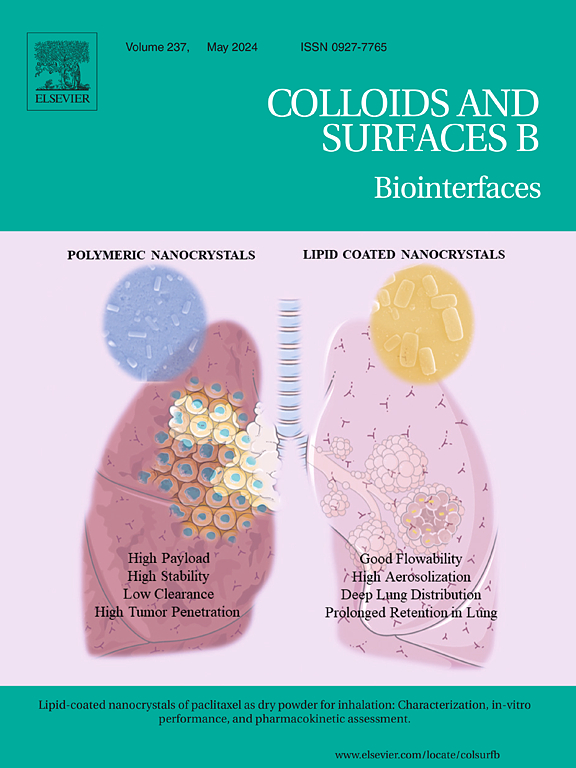大麻二酚口服制剂:提高可生物降解大麻二酚自乳化给药系统的绝对口服生物利用度
IF 5.4
2区 医学
Q1 BIOPHYSICS
引用次数: 0
摘要
目的制备和评价三种不同的SEDDS制剂,提高大麻二酚(CBD)的口服生物利用度。由于其亲脂性和广泛的首过代谢,CBD的口服生物利用度有限。通过在SEDDS配方中使用不同的乳化剂,本研究旨在优化CBD的负载能力,并提高CBD口服时的整体体内药代动力学(PK)性能。方法采用3种乳化剂:1)无聚甘油(PG)乳化剂,2)两性混合磷脂酰胆碱/短链聚乙二醇乳化剂,3)长链聚乙二醇乳化剂。研究了SEDDS制剂的体外表面特性、脂溶性和粘液渗透性,并将其药代动力学特征与市售CBD制剂Epidiolex进行了比较。结果成功研制出有效载荷增大(20 % w/w)的sedds。这些配方与水介质接触后迅速乳化,形成单分散液滴,在脂质核心内保留高水平的CBD(92.95-93.54 %)。黏液渗透性研究表明,空间和表面特异性参数,如疏水性和zeta电位,导致pg基SEDDS的渗透性增加,而peg基SEDDS的渗透性显著降低。此外,与基于peg的配方相比,基于pg的配方在脂肪酶和胰酶降解SEDDS时显示出更多的脂肪酸释放。口服SEDDS后的血浆CBD浓度表明,与Epidiolex(3.4 %)相比,pg基制剂的绝对生物利用度更高(3.8 %)。此外,三种SEDDS的最大血浆浓度范围为30.6至35.8 ng/mL,超过了Epidiolex(25.0 ng/mL)。结论SEDDS作为一种有效的CBD口服给药系统,具有比Epidiolex更高的CBD血浆浓度。此外,与Epidiolex相比,可生物降解的pg基SEDDS显示出更高的绝对生物利用度,这强调了配方设计在优化口服给药系统中的重要性。本文章由计算机程序翻译,如有差异,请以英文原文为准。
Oral formulations for cannabidiol: Improved absolute oral bioavailability of biodegradable cannabidiol self-emulsifying drug delivery systems
Aim
This study aimed to fabricate and evaluate three different SEDDS formulations to improve the oral bioavailability of cannabidiol (CBD). CBD has limited oral bioavailability due to its lipophilicity and extensive first-pass metabolism. By using different emulsifiers in the SEDDS formulations, this study seeks to optimize CBD loading capacities and enhance overall in vivo pharmacokinetic (PK) performance of CBD when administered orally.
Methods
SEDDS were developed using three types of emulsifiers: 1) PEG-free polyglycerol (PG)-based, 2) mixed zwitterionic phosphatidylcholine/short-chain PEG-based, and 3) long-chain PEG-based. The SEDDS formulations were characterized in vitro for surface properties, lipolysis, and mucus permeation, and their pharmacokinetic profiles were compared with Epidiolex, a marketed CBD formulation.
Results
SEDDS with increased payloads (20 % w/w) were successfully developed. These formulations rapidly emulsified upon contact with aqueous media, forming monodisperse droplets that retained high levels of CBD (92.95–93.54 %) within the lipid core. Mucus permeability studies revealed that steric and surface-specific parameters, such as hydrophobicity and zeta potential, led to increased permeability for PG-based SEDDS, while PEG-based SEDDS had significantly reduced permeation. Furthermore, PG-based formulations exhibited increased fatty acid release upon SEDDS degradation with both lipase and pancreatin compared to PEG-based formulations. The plasma CBD concentration following oral administration of the developed SEDDS suggested higher absolute bioavailability of the PG-based formulation (3.8 %) compared with Epidiolex (3.4 %). Additionally, the maximum plasma concentrations for the three developed SEDDS ranged from 30.6 to 35.8 ng/mL, surpassing that of Epidiolex (25.0 ng/mL).
Conclusion
These findings underscore the potential of SEDDS as an effective oral delivery system for CBD, capable of achieving higher CBD plasma concentrations than Epidiolex. Additionally, the biodegradable PG-based SEDDS demonstrated improved absolute bioavailability compared to Epidiolex, emphasizing the importance of formulation design in optimizing oral drug delivery systems.
求助全文
通过发布文献求助,成功后即可免费获取论文全文。
去求助
来源期刊

Colloids and Surfaces B: Biointerfaces
生物-材料科学:生物材料
CiteScore
11.10
自引率
3.40%
发文量
730
审稿时长
42 days
期刊介绍:
Colloids and Surfaces B: Biointerfaces is an international journal devoted to fundamental and applied research on colloid and interfacial phenomena in relation to systems of biological origin, having particular relevance to the medical, pharmaceutical, biotechnological, food and cosmetic fields.
Submissions that: (1) deal solely with biological phenomena and do not describe the physico-chemical or colloid-chemical background and/or mechanism of the phenomena, and (2) deal solely with colloid/interfacial phenomena and do not have appropriate biological content or relevance, are outside the scope of the journal and will not be considered for publication.
The journal publishes regular research papers, reviews, short communications and invited perspective articles, called BioInterface Perspectives. The BioInterface Perspective provide researchers the opportunity to review their own work, as well as provide insight into the work of others that inspired and influenced the author. Regular articles should have a maximum total length of 6,000 words. In addition, a (combined) maximum of 8 normal-sized figures and/or tables is allowed (so for instance 3 tables and 5 figures). For multiple-panel figures each set of two panels equates to one figure. Short communications should not exceed half of the above. It is required to give on the article cover page a short statistical summary of the article listing the total number of words and tables/figures.
 求助内容:
求助内容: 应助结果提醒方式:
应助结果提醒方式:


